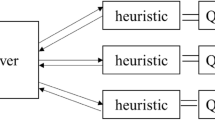Abstract
We address the problem of determining the topology and bridge-capacity assignments for a network connecting a number of token rings via source-routing bridges. The objective is to minimize the cost of bridge installations while meeting the network users' performance requirements. The problem is modeled as a mixed 0–1 integer program. A comparison is given between two solution algorithms: a simulated annealing algorithm using the flow-deviation algorithm for each routing subproblem, and a drop algorithm using the simplex method for the same subproblems to provide benchmark solutions. In the former algorithm, the routing subproblem is formulated as a nonlinear program with penalty functions to model node and link capacity constraints, and in the latter as a multicommodity flow model with the same capacity constraints. Computational results show that the simulated-annealing/flow-deviation algorithm produced substantially better solutions than the LP-based drop algorithm.
Similar content being viewed by others
References
R.R. Boorstyn and H. Frank, Large scale network topological optimization, IEEE Trans. Commun. COM-25(1977)29–46.
W. Bux, Token-ring local-area networks and their performance, Proc. IEEE 77(1989)238–256.
J.J. Dongarra, Performance of various computers using standard linear equations software, Technical Report CS-89-85, Computer Science Department, University of Tennessee, Knoxville, TN (1993).
P.C. Fetterolf and G. Anandalingam, Optimizing interconnection of local area networks: An approach using simulated annealing, ORSA J. Comput. 3(1991)275–287.
P.C. Fetterolf and G. Anandalingam, A Lagrangian relaxation technique for optimizing interconnection of local area networks, Oper. Res. 40(1992)678–688.
L. Fratta, M. Gerla and L. Kleinrock, The flow deviation method: An approach to store- and-forward computer communication network design, Networks 3(1973)97–133.
B. Gavish, A general model for the topological design of computer networks,GLOBECOM-86 (1986) pp. 1584–1588.
B. Gavish, Topological design of computer communication networks — The overall design problem, Euro. J. Oper. Res. 58(1992)149–172.
B. Gavish and K. Altinkemer, Backbone network design tools with economic tradeoffs, ORSA J. Comput. 2(1990)236–252.
B. Gavish and I. Neuman, A system for routing and capacity assignment in computer communication networks, IEEE Trans. Commun. COM-37(1989)360–366.
B. Gavish, B. Trudeau, P. Dror, M. Gendreau and L. Mason, Fiber optic circuit network design under reliability constraints, IEEE J. Select. Areas Commun. SAC-7(1989)1181–1187.
A.M. Geoffrion, Lagrangian relaxation for integer programming, Math. Progr. 2(1974)82–114.
M. Gerla and L. Kleinrock, On the topological design of distributed computer networks, IEEE Trans. Commun. COM-25(1977)48–60.
M. Gerla and L. Kleinrock, Congestion control in interconnected LANs, IEEE Networks 2(1988)72–76.
S. Gupta and K.W. Ross, Performance modeling and optimization of networks of bridged LANs, Queueing Systems 9(1991)113–132.
Vendor Master Directory and Vendor Catalogs on CD-ROM, Information Handling Services, Englewood, CO (1993).
A. Kershenbaum, P. Kermani and G. Grover, MENTOR: An algorithm for mesh network topological optimization and routing, IEEE Trans. Commun. COM-39(1991)503–513.
P.J.M. van Laarhoven and E.H.L. Aarts,Simulated Annealing: Theory and Applications (Reidel, Dordrecht, 1987).
L.J. LeBlanc, Mathematical programming algorithms for large-scale network equilibrium and network design problems, Ph.D. Dissertation, Department of Industrial Engineering and Management Sciences, Northwestern University, Evanston, IL (1973).
T.L. Magnanti and R.T. Wong, Network design and transportation planning: Models and algorithms, Transport. Sci. 18(1984)1–55.
T. Mikkelson, Network Systems Corp., private communication.
C.L. Monma and D.D. Sheng, Backbone network design and performance analysis: A methodology for packet switching networks, IEEE J. Select. Areas Commun. SAC-4(1986)946–965.
C.H. Papadimitriou, The complexity of the capacitated tree problems, Networks 8(1978)217–230.
J.S. Park, R. Bartoszynski and W.A. Rosenkrantz, Stability ofp-persistent CSMA/CD, ORSA J. Comput., to be published.
J.S. Park and K. Kang, Delay analysis of multidimensional queueing process in CSMA/CD local area networks, Telecom. Syst. 1(1993)217–242.
J.S. Park and V. Sridhar, Optimal interconnection of token ring networks using source routing bridges,Proc. Telecommunication Systems Conf., Vanderbilt University, Nashville, TN (1993) pp. 463–475.
R. Perlman,Interconnection: Bridges and Routers (Addison-Wesley, Reading, 1992).
V. Sridhar, Optimal design of interconnected local area networks, Ph.D. Dissertation, Department of Management Sciences, The University of Iowa, Iowa City, IA (1994).
H. Takagi, Application of polling models to computer networks, IBM Research Report RT 0032 (1990).
L.G. Valiant, The complexity of enumeration and reliability problems, SIAM J. Comput. 8(1979)410–421.
Data Sources — The Complete Computer Product Book: Hardware and Data Communications Volume (Ziff-Davis Publ., New York, 1993).
Author information
Authors and Affiliations
Rights and permissions
About this article
Cite this article
LeBlanc, L.J., Park, J.S., Sridhar, V. et al. Topology design and bridge-capacity assignment for interconnecting token ring LANs: A simulated annealing approach. Telecommunication Systems 6, 21–43 (1996). https://doi.org/10.1007/BF02114284
Issue Date:
DOI: https://doi.org/10.1007/BF02114284




